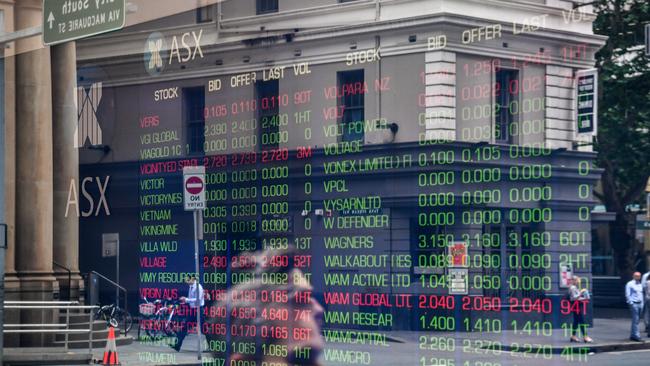ASX drops 2.5pc on global virus, trade worries
Investors wiped $46bn off the ASX as a resurgence of coronavirus and trade concerns drove risk aversion in global markets.

Investors wiped $46bn off the local bourse as a resurgence of coronavirus and geopolitical factors caused heightened risk aversion in global markets after huge gains since March due to unprecedented fiscal and monetary policy stimulus in response to the pandemic.
In its worst day in the past two weeks, Australia’s benchmark ASX 200 index dived 2.5 per cent to a seven-day low of 5817.7 points as the pandemic worsened in the US and Australia, the International Monetary Fund cut its 2020 global growth forecast to minus 4.9 per cent, the US outlined $US3.1bn ($4.5bn) of EU tariffs in retaliation for Airbus subsidies, and the Pentagon named 20 Chinese companies with links to China’s military.
Oil Search fell 7 per cent after West Texas crude futures tumbled on the back of a higher-than-expected US inventories, Unibail-Rodamco-Westfield dived 8 per cent on coronavirus worries, Afterpay fell 4 per cent after hitting a record high a day earlier, and Westpac lost 3.5 per cent.
The Australian dollar slipped to US68.48c from US69.45 a day earlier, while Australian 10 year government bond yields fell 4 basis points to 0.88 per cent.
After falling 39 per cent from a record high of 7197.2 to a seven-year low of 4402.5 in the February-March bear market, the local market bounced 41 per cent to a three-month high of 6198.6 early this month as record stimulus sparked the fastest bull market on record. “Markets continue to seesaw as uncertainty still prevails, with talk of virus spikes in the US unsettling markets there and the breakout in Victoria causing some concerns here,” says Bell Potter’s Richard Coppleson.
“We have some of the smartest guys in the market saying its overvalued and due for a very big fall or collapse. The only problem is most of them were saying that two and three months ago and in that time the US has rallied over 50 per cent and Australia by over 40 per cent.
“The market will not go all the way back to down because there is too much cash on the sidelines.”
However, S&P 500 futures extended their fall to 1.3 per cent after the market closed, pointing to another rough night on Wall Street after the US benchmark fell 2.6 per cent overnight.
In Asia, Japan’s Nikkei 225 fell 1.2 per cent and South Korea’s KOSPI fell 2.3 per cent, while markets in China, Hong Kong and Taiwan remained closed for Dragon Boat Day.
Credit Suisse Australia macro strategist Damien Boey says while Australian equities are cheap relative to US equities, he’s concerned that “not enough is being done by domestic policy makers to contend with the challenges faced by domestic cyclicals and financials”.
“Stocks might be cheap, but if the government is not committed to large-scale fiscal stimulus at this sensitive time, and if the economy is externally shutdown through soft border closures, there is still plenty of risk and volatility in the domestic cycle to navigate, centring on the housing market,” he cautions.
“We also think that if the government does choose to increase stimulus, it will be in infrastructure rather than housing. For these reasons, we are happy to buy the market index, but excluding housing-related exposures. By default, this positioning puts us in resources, some capex names, and selected high quality industrial exposures.”
UBS analyst Glyn Lawcock has upgraded his forecasts for base metals including copper and nickel by more than 10 per cent for 2020 to reflect a higher-than-expected June quarter outcome and his expectation that prices lift further in the second half.
He also raised his spot iron ore forecasts on the back of under-delivery by Brazil, forecasting $US91 a tonne forecast for 2020, but maintained that $US100 a tonne is “unsustainable” for the long-term. Meanwhile he has lowered coal price forecasts again, but he says it’s “near the bottom with the majority of the cost curve under water on an all-in basis”.
“We advocate switching precious metals into base metals and laggards,” Lawcock says.
He notes the re-emergence of COVID-19 or a broader sell-off in global markets remain the biggest risks to a further lift in base metal prices and related equities in the second half, while supply constraints provide fundamental support. “To date, consumer appetite has been stronger than expected as mobility restrictions are lifted, plus we have unprecedented monetary and fiscal stimulus which is expected to drive increased demand,” he says. “Further support is likely to come from under investment by the miners with significant capital deferred by up to 12 months as a result of COVID.”



